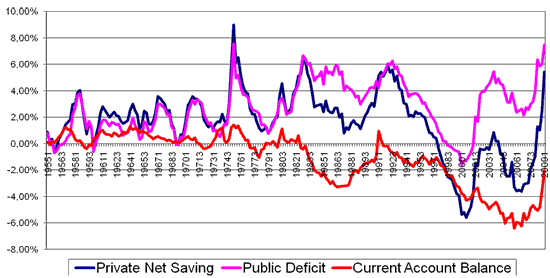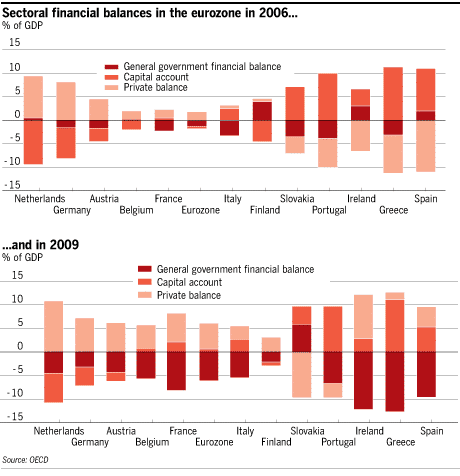Economics 101 on government budget deficits
Econ 101
Imagine you and I are the only two people in an economy. For the sake of argument, say we use sea shells as a currency and we trade with no one else but each other. So when we do trade, we exchange goods and services with each other for the amount of sea shells these goods and services are worth. From an accounting perspective, it’s a wash; if you buy my goods, I get the sea shells and lose the goods of equivalent value and if I buy from you, you get the shells and I get the goods of equivalent value. So far, so good.
Now, let’s bring a third person into the mix, Harry. Harry is a foreigner with whom we agree to do business. Where he’s from, he uses silver as his currency. No matter; in trading with Harry, we agree to an exchange rate between our sea shells and his silver and we are ready to go. Now, we can trade with each other and with Harry. If Harry buys from either of us, we get silver and he gets an equivalent value of goods. If we buy from Harry, he gets sea shells and we get the goods, also equivalent in value to the shells.
Notice that in both examples there is no value ‘leakage’ in the system. Everyone gets a fair deal, goods for a currency amount equivalent in value to those goods. So, from an accounting perspective, we can trade as much as we want with each other and with Harry and all that is being done is a transfer of goods, services and currency between us. That’s Econ 101.
Deficits
Now, let’s introduce some deficits and debt into the scenario. For the sake of argument, let’s say that year in, year out we produce the same amount, the same value of stuff. However, in one particular year, you produce a lot of stuff – and I want to buy it. The problem is that I produce less stuff that you want to buy. What do we do? I could issue you an I.O.U. and tell you I will pay you back sometime later. You accept the deal and now I have received the goods and services and you have received an equivalent value from the two sources, currency and the I.O.U. Again, it is a wash from an accounting perspective. I have a deficit in this particular year and you have a surplus.
Now, even if we add Harry and his silver and foreign goods into the mix, it’s pretty much the same. For example, if you bought some of Harry’s services but didn’t have enough sea shells to pay for it, you could issue an I.O.U. to him for the shortfall. You would have a deficit with Harry for the year and Harry would have a surplus with you for the year. So, even when we introduce debt and deficits into an economy, the accounting is the same; there is no value leakage.
The government, the private sector and the foreign sector
What holds in my little example for three people also holds for three groups of people too. You could have 100 million people in a group that you represent that does trade with my group and Harry’s group and the accounting would be identical. So, let’s give our groups names. I am the government, you are the non-government sector and Harry is the foreign sector. The sea shells are the domestic currency and the silver represents foreign currencies.
- Me – government
- You – non-government sector
- Harry – foreign sector
- Sea Shells – domestic currency
- Silver – foreign currency
What should be clear from my example is that when the government has a deficit in any period, by definition the non-government sector (foreign plus private) must have a surplus of exactly the same amount. I have shown this to you in the past.
Real world examples of the financial sector balances
For example, I used Martin Wolf’s charts to show how Japan’s government and non-government sectors have balanced in my January post "Revisiting the sectoral balances model in Japan." The charts are below.
However you present the information, you get a balance. Here are two charts I used from Scott Fullwiler in a November post Barack Obama: “if we keep on adding to the debt… that could actually lead to a double-dip” showing the same phenomenon in the U.S.
And finally there is the European example from Spain’s debt woes and Germany’s intransigence lead to double dip. In that March post using another great chart from the FT’s Martin Wolf, I said:
The first thing to realize is that government deficits are balanced by imports and private savings. I’m talking here about the financial sector balances, of course.
The chart to the left from the FT shows you that the collective financial balances in each individual Eurozone country must sum to zero. Where there is a government surplus it is matched by either the capital account or private balances. The same is true for deficits. Take Spain, for example. There, the government’s budget was in surplus in 2006 and it had a very large capital account surplus (the financial sector equivalent of a current account/trade deficit). This was matched by a substantial private sector deficit. By 2009, due in large part to an unprecedented housing bust, the government’s finances were in tatters. Look at the chart. This is matched by net private sector savings and a capital account surplus. The financial sectors must balance.
Conclusion: the financial sectors must balance
Notice I haven’t talked about government as the creator of currency and the private sector as the user of currency. I haven’t focused on any misallocation of resource or malinvestment issues. I haven’t raised the spectre of inflation or currency depreciation. I have simply presented the economics and accounting of budget deficits.
The other stuff is where the politics and the ideology come into play but the accounting of federal government deficits is clear. When the government sector runs a deficit, the non-government sector runs a surplus of equivalent size. Draw your own conclusions about what this means in an era of government fiscal austerity.



Hope you have time for an answer.
Let’s say that you had given away a bunch of shells to prop up seafood shops and car dealers, yet you needed more to help companies create jobs for a lot of people. Many people who are particular fans of seafood don’t want you to do this because they know it will decrease the value of the shells they hold. But if things keep going like they are those people will have all the shells and everything will grind to a stop, or those with no shells will become very mad and may lose control.
So you throw a bunch of mollusk aphrodesiac into the bay and make a whole bunch more shells to give out. Since you have just increased the supply the shells should become cheaper, which has the net effect of making your goods cheaper (and thus more desireable) by those with silver. Many years later you could break up some of the shells to make them worth more, but for now it seems like an excellent plan.
What’s the downside, please? Thank you for your work, btw.